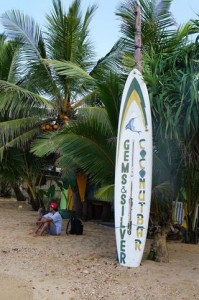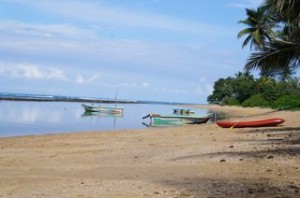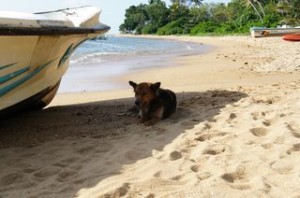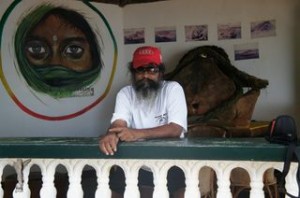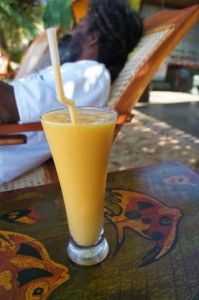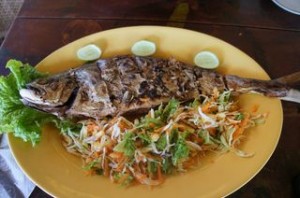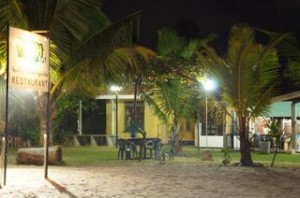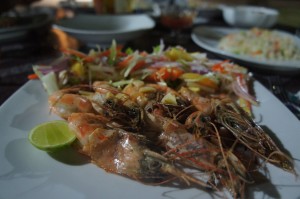Boarding Sri Lanka Airlines feels like I’ve already landed in Sri Lanka. A flight attendant dressed in a traditional sari greats me with a bow and the words “aayu-bowan,” which I later learn means “be blessed”in Sinhalese, the national language. Each attendant wears a low bun, flawless make up and the most pleasant demeanor. I have the good fortune of sitting next to Vishaka on the 10-hour plane ride. She guesses that I’m American and that this is my first trip to Sri Lanka. She explains that she’s returning to her home country after visiting her eldest son in graduate school in Fargo, N.D., and she immediately offers up her home and a tour around Colombo. Vishaka is the perfect example of Sri Lankan friendliness and hospitality. I’m visiting Sri Lanka because my friend Sid, known as Sujith in his birth country, has been hospitable enough to invite me for a visit, put me up in his family’s guest house and take me on a tour of the island, about the size of West Virginia.
I met Sid almost exactly a year ago on New Year’s Eve at a party while standing in line waiting for the bathroom. I don’t remember exactly how the conversation went, but he told me that he was from Sri Lanka, he thought I was nice and wondered if we could hang out sometime. Since then, he’s been my unofficial ambassador to Sri Lanka, making the only Sri Lankan dish he knows how for me (biriyani), giving me a lesson in cricket at the only cricket field in D.C. near the Tidal Basin. I still don’t get the game, which isn’t at all like baseball by the way, but I appreciated the effort. Sri Lanka was host of last year’s cricket world championships, an extreme honor for the country’s national pastime. Sid also made sure that I got a taste of Sri Lanka when I traveled to London last year and I met his sister Iresha, who made me a delicious dahl.
So, when my plane touched down in Sri Lanka’s capital, Colombo, I had some sense of the culture that I’d encounter and friendliness was a given. I ran into Vishaka again at baggage claim where she made sure that I was OK and reminded me to call her to visit while I was in the country. Then, I hopped into a white minibus with Sid and his cousin Pradip, who was driving. Pradip is what you might call a defensive and maybe a slightly aggressive driver. But you kind of have to be here. The two-hour drive from Colombo to Moragalla was an exercise in dodging and darting to avoid buses, dump trucks and other large vehicles that insisted upon driving on the center line rather than choosing the left or right lane. Honking is necessary to express “get out of the way” or what the “heck are you doing?” A man on a small motorbike looked at us incredulously after we honked at him for hogging the road. Shortly thereafter we spotted a trio of cows meandering down the median of the busy thoroughfare. Sid said we weren’t even driving during rush hour. Then there are the tuk-tuks, small three-wheeled, open vehicles that Sid said were like mosquitos. “They’re everywhere.” Some of them are pimped out with airbrushed photos inside or festive lights on the outside. We were driving so fast that I didn’t get a picture of one, but I’ll make it my mission when we go back to Colombo later in the week. The tuk-tuks were in full force on Galle Road along Colombo’s main open-air market, which was already bustling around 5:30 in the morning. Lights were a blaze in stalls selling cell phones and sim cards, while coconut vendors set up their carts on almost every corner. School children wore pristine white uniforms as they waited for buses to take them to school. The girls wore bright colored neck ties with their crisp white uniforms.
When I first spot the Indian Ocean, an early morning haze rests over it. We are still on Galle Road and people are walking and jogging alongside it like Chicago’s lakefront. An open-air train follows the ocean North or South with its conductors dripping from its doors and people jostling, arm to arm inside. I’ve been reading Paul Theroux’s Ghost Train to the Eastern Star, where he takes a train in Sri Lanka from Colombo to Galle. A ticket teller tells him that he doesn’t need a ticket to board the train, or a seat assignment, just push. I can tell that Theroux was right on with his description. I ask Sid about low-lying shacks on the side of the road. He tells me that this is like Sri Lanka’s projects. The traffic starts to thin, the road narrows and the houses and yards get larger. Soon we are in the town of Morgalla where Sid’s family lives. I’m staying in the guest house just behind the family home, a cozy 5 bedroom bungalow with a raised pool, surrounded by mango and coconut trees. The time difference between Sri Lanka and the US is insane. By now it is about 8 am Tuesday in Sri Lanka, but late evening Monday in the US. I consider taking a nap, but we decide it’s best to nap on the beach and we head to Sid’s uncle’s beach bar, guest house and gem shop.
Much of Moragalla seems to be home to the da Silvas–aunts, uncles, cousins or just people that you call cousin. It definitely has a Southern small town feel. As we take the 10 minute walk to his uncle’s place, Sid greats all manner of first and second cousins along with some people that have known him since childhood, but that he struggles to remember. He points out the homes of aunts, uncles and even his brother-in-laws family home. Everyone seems to live within a 10 block radius of one another. We pass some modest low-lying homes with tile roofs and other colorful two-story homes with gated entryways. Almost all homes have expansive yards. Sid says most of the people here are well-off because they are in the hospitality business as much of his family is.
Sid’s Uncle Emil has created a small paradise for himself. As we enter the grounds of his home and guest house, we are surrounded by lush tropical foliage broken by gravel pathways. His home is painted in festive pastels and surrounded by a veranda, we pass through a building under construction and Sid explains that it will be the hotel of yet another uncle, then we are on the beach. His Uncle Emil’s bar, known as theCoconut Bar, is situated on a lovely patch of sand facing the Indian Ocean. His uncle isn’t there when we arrive, so we take a stroll down the beach for a bit, along an even stretch of calm water. The rougher waves of the ocean crash over a reef, creating a natural pool along the beach with water that feels like a warm bath. On our walk we’ve been joined by a couple of Uncle Emil’s dogs, the leader being Beru. He’s a brown and black fuzzy mix of something and has a tail with a curl on the end. He almost marches confidently a head of us, stopping when we stop and looking back to be sure we are still following his lead. Sid points out small rocky outcrops peaking out from the ocean. Some are small islands to be visited. Small hotels and guest houses line the beach, some are under construction or in some level of repair. This stretch of Sri Lanka was hit fairly hard by the 2004 tsunami, particularly the Coconut Bar as I’d later learn.
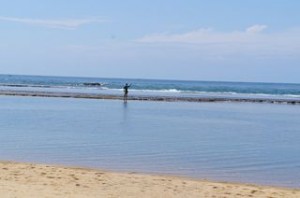
When we return from our walk, Uncle Emil still hasn’t returned so Sid leaves me on the beach for a bit to go find him. As I sit, a number of Sri Lankans pass by and look at me curiously. They all smile and nod, but I am sure my cornrowed hair is something they rarely see and they aren’t sure what to make of me. Finally, a trio of guys walk by and one calls out, “Good morning.” I greet him in return. “Where are you from?” I reply. “Oh, you look Jamaican,” he says. And, then asked as if I’d dropped out of the sky, “What are you doing here?” I explained that I was visiting my friend Sujith and asked if he knew him. He nodded and the trio continued on its way. I’ve noticed the curious looks since I boarded the plane for Sri Lanka. Fellow passengers stole looks as I made my way to the bathroom. On the ride to Morgalla, a group of students stared outright. I waved and they smiled. It’s a friendly curiosity. Sid explained that Sri Lankans don’t see many African-Americans or Americans in general. They are used to the Brits, Germans, Dutch and now Russians who vacation there regularly.
When I finally meet Uncle Emil, I can understand why the trio of guys may have thought I was from Jamaica. Uncle Emil sports locs and a long beard peppered with grey. The Coconut Bar has hints of a Jamaican decor with yellow, red and green accents. Uncle Emil has an easy smile and greets me with a hug. I can see why he’s Sid’s favorite uncle. We eventually settle into cane chairs with drinks. I have a fresh mango juice. I’d already had coconut water straight from the coconut earlier. It seems the current Coconut Bar is a shadow of its former self, suffering a direct hit from the 2004 tsunami. Sid’s uncle explains how on that day he was sitting in a cane chair just as we are now when he saw the ocean recede and a massive wave approach. He said it happened in an instant. He was engulfed and tossed about as if ina washing machine and left to live atop the coconut tree next to his decimated bar. His bar, guest house and diving school suffered a million dollars in damages. He left the experience determined to rebuild and rebuild bigger. Uncle Emil is something of a renaissance man. His main business is as a gem exporter and jewelry designer. He also has a young tea plantation. And, then there’s the hospitality thing. He proceeds to offer up drinks and food. I have a pina colada with fresh coconut milk, I have a whole grilled golden mackerel for lunch with a delicious mixed salad containing sweet bits of pineapple and later a fruit salad of mango and banana. All of the ingredients recently plucked from the sea or a tree.
After a full day of napping, bathing in the ocean and eating. There is more eating to be done. We head back to Sid’s home where I greet a bevy of aunts, sisters and nieces. They parade through the door of the home and onto the porch shyly, and I kiss each on each cheek. Iresha, Sid’s sister who I visited in London is one of them. I try chatting with one of Sid’s nieces studying English in school and she shyly talks about her recent trip to Australia before darting back into the house.
Uncle Emil picks us up for dinner and we head to another family outpost, the Fresh Restaurant, where we meet more of Sid’s cousins, a pair of brothers. The eatery is a part of a hotel and sits on expansive piece of beach. It is is the epitome of beach casual with plastic chairs and rounds and strings and we sit where we like. Uncle Emil orders a bottle of white wine, and fresh french fries, or chips as they call them here, are delivered to the table. Sid, his uncle and cousins start the story telling and joking in Sinhalese, with classic Sinhalese tunes playing in the background. The songs sound like salsa at times, then Bollywood and even tinges of reggae. Maybe the salsa sounds come from the country’s Portugese heritage, Bollywood from the proximity to India and reggae, just because Sri Lankans love reggae. After a couple of drinks one of Sid’s cousins breaks into song and we polish of plates of prawns the size of my hand and tasty fried rice made with basamati and vegetables. More wine is poured and I’m pretty sure that I’m going to like this place.
